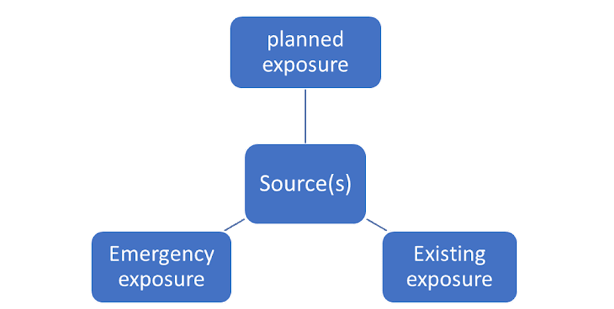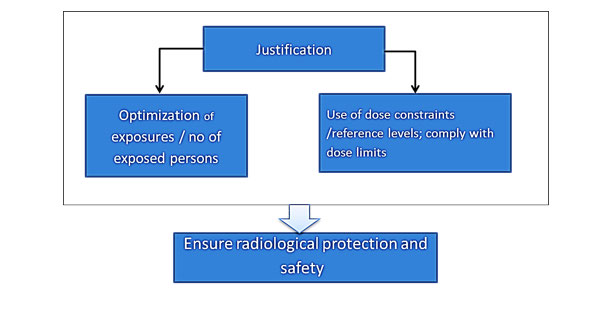Primary dose limits
The primary dose limits are based on the stochastic risk (cancer / genetic risk) estimates, which are mainly based on the data from the survivors of nuclear bomb explosions over Hiroshima and Nagasaki. The compliance to the limits should be seen after adding doses received from external sources and internal dose component as estimated by bioassay and wholebody counting methods.
External dose + Internal dose ≤ Annual effective dose limit
ICRP (2007) recommended dose limits
| Type of limit | Occupational | Public |
| Effective dose | 20 mSv/y, averaged over defined periods of 5 years. In any single year, the effective dose should not exceed 50 mSv. In India, the years max. dose limit is lower at 30 mSv in a single year. | 1 mSv/y. In special circumstances, a higher value could be allowed in a single year, provided that the average over 5 years does not exceed 1 mSv/y. |
| Annual equivalent dose in: | ||
| Lens of the eye | 20 mSv/y | 15 mSv/y |
| Skin (averaged over 1 cm2 of skin regardless of the area exposed) | 500 mSv/y | 50 mSv/y |
| Hands and feet | 500 mSv | - |
ALI (in Bq) = 20 mSv divided by Effective dose coefficient for inhalation
DAC (in Bq /cubic meter) = ALI divided by 2400 cubic meter
Where, 1200 is the cubic meter of air breathed by the reference radiation worker in 2000 hours of his working in one year. The inhaled materials are classified into three absorption (dissolution) types in body fluids after intake, i.e., highly absorption (Type F), medium absorption (Type M) and slowly absorption type ((Type S).
Radioactive contamination of surfaces contributes for the airborne radioactivity in workplaces. Regulatory body also provides the derived levels for surface contamination to control the spread of contamination, which may result in contamination of the workers. The AERB Safety Manual (Rev. 4, 2005) gives the derived working levels for contamination, which are applicable in the Indian facilities. The dose records of all the occupational workers need to be maintained by the management of the facility for the duration as specified by the national regulatory body.
Personal decontamination
Soap and warm water, with mild scrubbing can easily remove the external skin contamination. In general, gentle washing for about a minute will remove 0ver 95 % of the contamination present on intact skin. For persistent contamination, other radionuclide-specific chemical decontamination agents, such as sodium bicarbonate, dilute EDTA solution need to be used. Expert guidance may be necessary under such conditions.
Temporary / itinerant workers
The BSS do not prescribe separate dose limit for temporary workers. In India, the national regulatory body has certain stipulations. Employment of Temporary workers in radioactive areas my be done only after giving them adequate training in radiation protection and safe work procedures under the guidance of concerned safety officer (RSO). Medically fit person above the age of 18 y can only be employed. Management need to maintain record of the dose (Dose passport) received by the workers.

